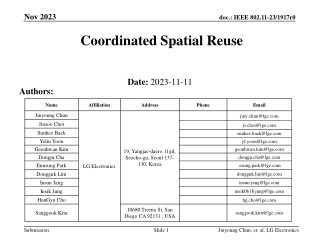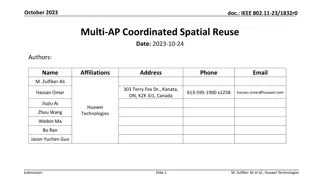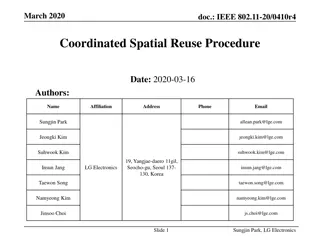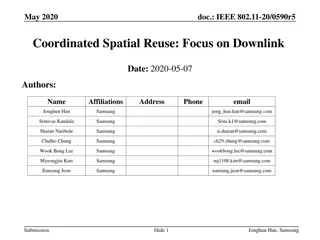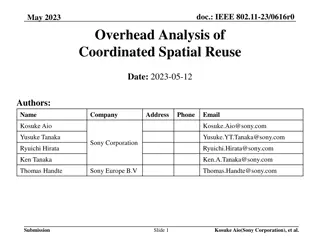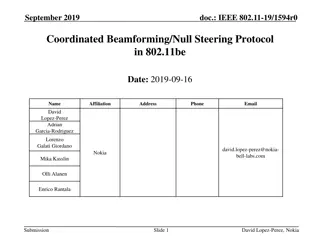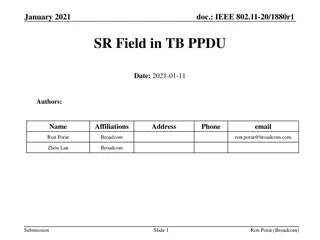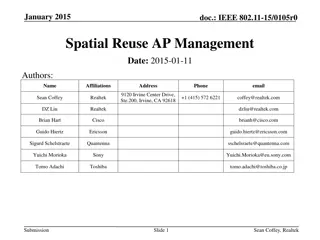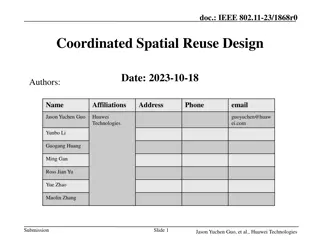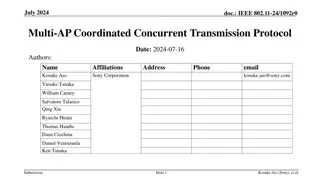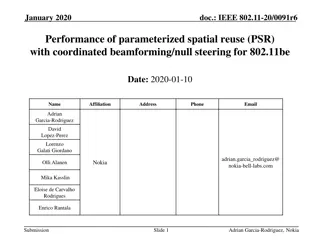Coordinated Spatial Reuse in IEEE 802.11 Networks
This document delves into Coordinated Spatial Reuse (C-SR) in IEEE 802.11 networks, focusing on downlink operations. It explains the C-SR procedure, performance gains, coordination policies, and phases involved in optimizing spectrum efficiency through multi-AP coordination. The authors from Samsung investigate various aspects of C-SR operations to enhance network performance.
Uploaded on Apr 22, 2025 | 0 Views
Download Presentation

Please find below an Image/Link to download the presentation.
The content on the website is provided AS IS for your information and personal use only. It may not be sold, licensed, or shared on other websites without obtaining consent from the author.If you encounter any issues during the download, it is possible that the publisher has removed the file from their server.
You are allowed to download the files provided on this website for personal or commercial use, subject to the condition that they are used lawfully. All files are the property of their respective owners.
The content on the website is provided AS IS for your information and personal use only. It may not be sold, licensed, or shared on other websites without obtaining consent from the author.
E N D
Presentation Transcript
StudyMafia.Org Design of Experiments Submitted To: Submitted By: Studymafia.org Studymafia.org
Table Contents Definition Introduction Components of DOE Types of DOE Purpose of DOE Conclusion 2
Definition Design of Experiments (DOE) is also referred to as Designed Experiments or Experimental Design are defined as the systematic procedure carried out under controlled conditions in order to discover an unknown effect. 3
Introduction Experimental design can be used at the point of greatest leverage to reduce design costs by speeding up the design process, reducing late engineering design changes, and reducing product material and labor complexity. Designed Experiments are also powerful tools to achieve manufacturing cost savings by minimizing process variation and reducing rework, scrap, and the need for inspection. 4
Components of DOE Factors, or inputs to the process. Factors can be classified as either controllable or uncontrollable variables. In this case, the controllable factors are the ingredients for the cake and the oven that the cake is baked in. Note that the ingredients list was shortened for this example - there could be many other ingredients that have a significant bearing on the end result (oil, water, flavoring, etc). 6
Components of DOE Levels Settings of each factor in the study. Examples include the oven temperature setting and the particular amounts of sugar, flour, and eggs chosen for evaluation. 7
Components of DOE Response, or output of the experiment. In the case of cake baking, the taste, consistency, and appearance of the cake are measurable outcomes potentially influenced by the factors and their respective levels. Experimenters often desire to avoid optimizing the process for one response at the expense of another. 8
Purpose of DOE Comparing Alternatives. In the case of our cake-baking example, we might want to compare the results from two different types of flour. If it turned out that the flour from different vendors was not significant, we could select the lowest- cost vendor. If flour were significant, then we would select the best flour. 10
Purpose of DOE Identifying the Significant Inputs (Factors) Affecting an Output (Response) - separating the vital few from the trivial many. We might ask a question: "What are the significant factors beyond flour, eggs, sugar and baking?" 11
Purpose of DOE Achieving an Optimal Process Output (Response). "What are the necessary factors, and what are the levels of those factors, to achieve the exact taste and consistency of Mom's chocolate cake? 12
Purpose of DOE Reducing Variability. "Can the recipe be changed so it is more likely to always come out the same?" Minimizing, Maximizing, or Targeting an Output (Response). "How can the cake be made as moist as possible without disintegrating?" 13
Purpose of DOE Improving process or product "Robustness" - fitness for use under varying conditions. "Can the factors and their levels (recipe) be modified so the cake will come out nearly the same no matter what type of oven is used?" 14
Purpose of DOE Balancing Tradeoffs When there are multiple Critical to Quality Characteristics (CTQC's) that require optimization. "How do you produce the best tasting cake with the simplest recipe (least number of ingredients) and shortest baking time?" 15
Conclusion Design of experiments (DOE) is defined as a branch of applied statistics that deals with planning, conducting, analyzing, and interpreting controlled tests to evaluate the factors that control the value of a parameter or group of parameters. 17
Thanks To StudyMafia.org


